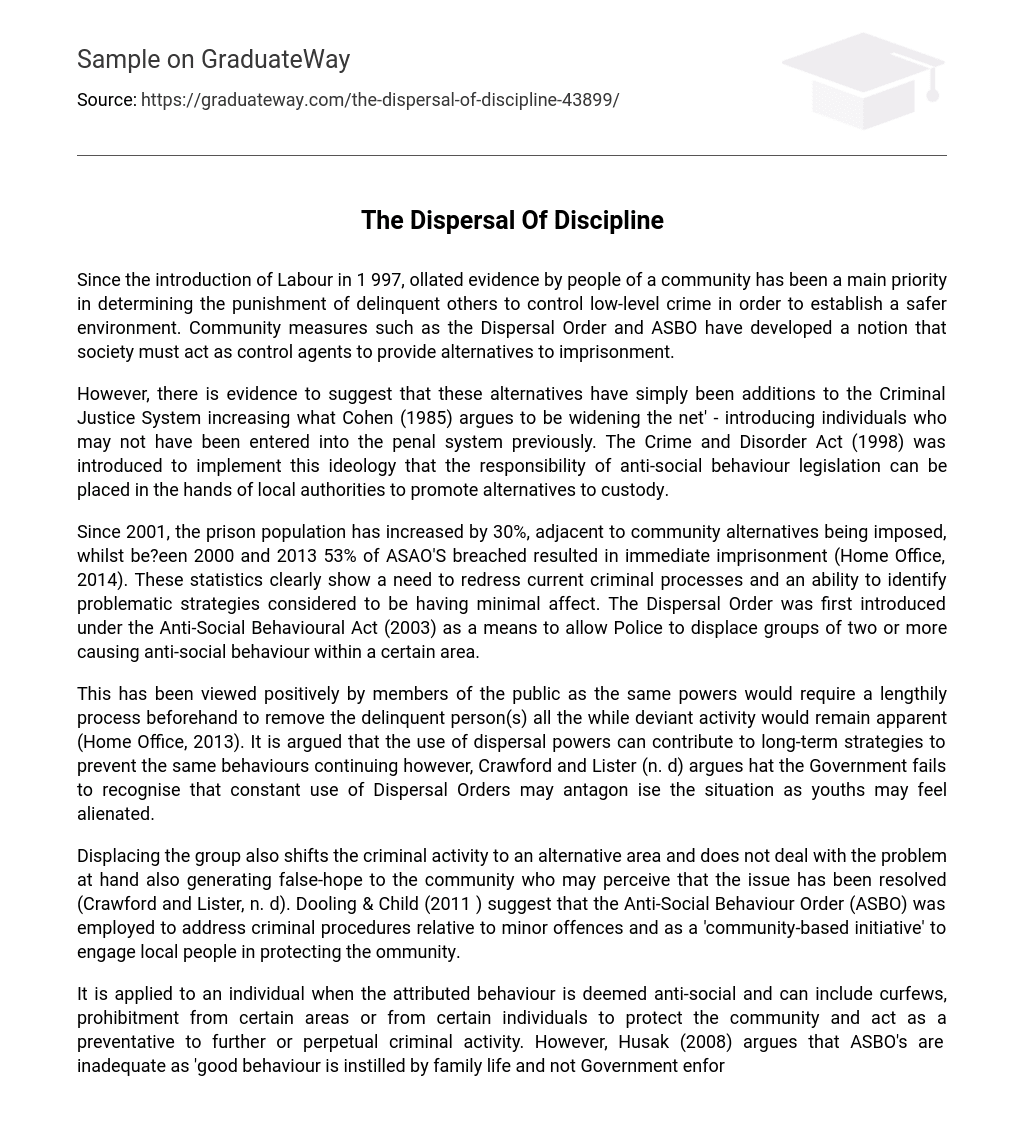Since the introduction of Labour in 1 997, ollated evidence by people of a community has been a main priority in determining the punishment of delinquent others to control low-level crime in order to establish a safer environment. Community measures such as the Dispersal Order and ASBO have developed a notion that society must act as control agents to provide alternatives to imprisonment.
However, there is evidence to suggest that these alternatives have simply been additions to the Criminal Justice System increasing what Cohen (1985) argues to be widening the net’ – introducing individuals who may not have been entered into the penal system previously. The Crime and Disorder Act (1998) was introduced to implement this ideology that the responsibility of anti-social behaviour legislation can be placed in the hands of local authorities to promote alternatives to custody.
Since 2001, the prison population has increased by 30%, adjacent to community alternatives being imposed, whilst be?een 2000 and 2013 53% of ASAO’S breached resulted in immediate imprisonment (Home Office, 2014). These statistics clearly show a need to redress current criminal processes and an ability to identify problematic strategies considered to be having minimal affect. The Dispersal Order was first introduced under the Anti-Social Behavioural Act (2003) as a means to allow Police to displace groups of two or more causing anti-social behaviour within a certain area.
This has been viewed positively by members of the public as the same powers would require a lengthily process beforehand to remove the delinquent person(s) all the while deviant activity would remain apparent (Home Office, 2013). It is argued that the use of dispersal powers can contribute to long-term strategies to prevent the same behaviours continuing however, Crawford and Lister (n. d) argues hat the Government fails to recognise that constant use of Dispersal Orders may antagon ise the situation as youths may feel alienated.
Displacing the group also shifts the criminal activity to an alternative area and does not deal with the problem at hand also generating false-hope to the community who may perceive that the issue has been resolved (Crawford and Lister, n. d). Dooling & Child (2011 ) suggest that the Anti-Social Behaviour Order (ASBO) was employed to address criminal procedures relative to minor offences and as a ‘community-based initiative’ to engage local people in protecting the ommunity.
It is applied to an individual when the attributed behaviour is deemed anti-social and can include curfews, prohibitment from certain areas or from certain individuals to protect the community and act as a preventative to further or perpetual criminal activity. However, Husak (2008) argues that ASBO’s are inadequate as ‘good behaviour is instilled by family life and not Government enforcement policies’ and it may be considered immoral to the perpetrator who may have family within the catchment area.
It is important to consider Cohen’s (1985) ‘Net-widening, Mesh Thinning etaphor when reflecting on the use of community alternatives to prison. Cohen argues that a sense of Wdening’ is prevalent in that new deviants are being bought into the criminal justice system by expansion of legislation whilst prevailing institutions (such as prisons) remain, a phenomenon statistically reinforced. The term ‘blurring’ is referred to as an ‘erosion of the boundaries Of social control’ (Adler & Gray, 201 0) and is used to suggest that an assumption has been established; community alternatives are cost effective and ‘more humane than custody. Lastly, Cohen argues that enevolent intentions to rehabilitate the individual and maintain order to protect the community are simply intrusive with the threat of custody if the punishment is not adhered to. Anti-social behaviour can be committed by an individual of any age however the strategies in place to both rehabilitate and act as an alternative to custody are focused primarily at youths. Taking into account Cohen’s fishing metaphor, it is of importance to consider Schur’s (1973) elaboration of the labelling theory (Becker, 1 963) providing an alternative approach to traditional thinking.
He argues that institutionalisation should take a ackseat’ and the improvement on the quality of life of the deviant youth should be at the forefront if the Government is to ever succeed in reducing the delinquency rate (Marticorena, 1979). The ambiguity of what constitutes anti-social behaviour has adverse implications when considering the dispersal of discipline. If one is to assume an individual is committing an act of anti-social behaviour based on the interpretation they perceive, how can government intervention be considered and criminal sanctions applied when the definition may simply be a result of annoyance or distaste?
This raises many questions and actions that need to e addressed so that community participation toward discipline is not heavily weighted in favour Of the victim and considers the, albeit, ‘offender at risk. In conclusion it may be understood that the use of ASB legislation is having a positive effect when considering crime control however, it is evident that these strategies are a clear embodiment of efficiency over justice as incarceration rates have not declined since their introduction.





